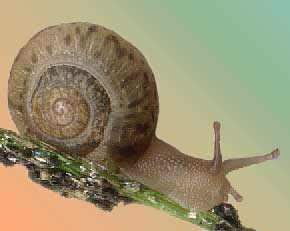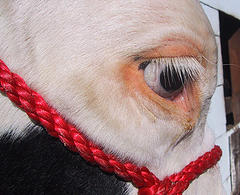ACETYLSERYLTYROSYLSERYLISOLEUCYLTHREONYLSERYLPROLYLSERYLGLUTAMINYLPHENYLALANYLVALYLPHENYLALANYLLEUCYLSERYLSERYLVALYLTRYPTOPHYLALANYLASPARTYLPROLYLISOLEUCYLGLUTAMYLLEUCYLLEUCYLASPARAGINYLVALYLCYSTEINYLTHREONYLSERYLSERYLLEUCYLGLYCYLASPARAGINYLGLUTAMINYLPHENYLALANYLGLUTAMINYLTHREONYLGLUTAMINYLGLUTAMINYLALANYLARGINYLTHREONYLTHREONYLGLUTAMINYLVALYLGLUTAMINYLGLUTAMINYLPHENYLALANYLSERYLGLUTAMINYLVALYLTRYPTOPHYLLYSYLPROLYLPHENYLALANYLPROLYLGLUTAMINYLSERYLTHREONYLVALYLARGINYLPHENYLALANYLPROLYLGLYCYLASPARTYLVALYLTYROSYLLYSYLVALYLTYROSYLARGINYLTYROSYLASPARAGINYLALANYLVALYLLEUCYLASPARTYLPROLYLLEUCYLISOLEUCYLTHREONYLALANYLLEUCYLLEUCYLGLYCYLTHREONYLPHENYLALANYLASPARTYLTHREONYLARGINYLASPARAGINYLARGINYLISOLEUCYLISOLEUCYLGLUTAMYLVALYLGLUTAMYLASPARAGINYLGLUTAMINYLGLUTAMINYLSERYLPROLYLTHREONYLTHREONYLALANYLGLUTAMYLTHREONYLLEUCYLASPARTYLALANYLTHREONYLARGINYLARGINYLVALYLASPARTYLASPARTYLALANYLTHREONYLVALYLALANYLISOLEUCYLARGINYLSERYLALANYLASPARAGINYLISOLEUCYLASPARAGINYLLEUCYLVALYLASPARAGINYLGLUTAMYLLEUCYLVALYLARGINYLGLYCYLTHREONYLGLYCYLLEUCYLTYROSYLASPARAGINYLGLUTAMINYLASPARAGINYLTHREONYLPHENYLALANYLGLUTAMYLSERYLMETHIONYLSERYLGLYCYLLEUCYLVALYLTRYPTOPHYLTHREONYLSERYLALANYLPROLYLALANYLSERINE
July 20, 2006
Longest
Check this out, this is the longest chemical term ever, and it's one word:
July 13, 2006
Octuple Vision?
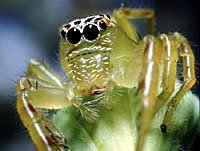
All spiders, arachnids, have eight legs.
But how many eyes do they have?
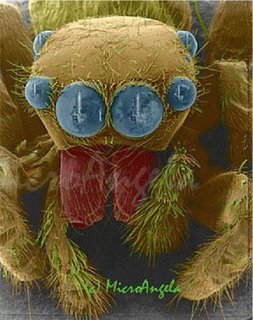
Most of them have eight eyes! Which enables them to have vision like this:
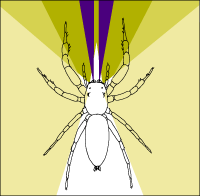
But most spiders don't have good eyesight, despite the many eyes. They depend more on their touch, vibration and taste stimuli.
However, hunting spiders, such as the 2nd picture above, have sharp vision in order to help catch prey.
June 29, 2006
How Do Butterflies Feed?
Ever wondered how butterflies suck the nectar from deep within the flowers?

Well, if you look at the picture below carefully, you will notice that there is like a rolled up ribbon -like thing where the mouth should be. That thing, is called a 'proboscis', which is a turbular sucking organ. When the butterfly has found nectar, it extends its proboscis like a party blow-out.
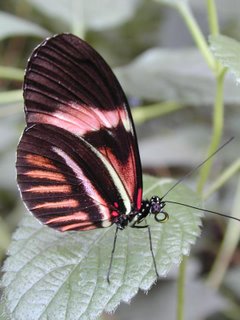
A Monarch Butterfly
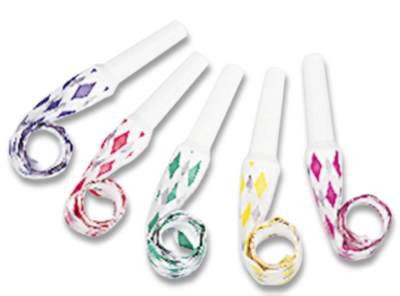
A butterfly's proboscis is like a party blow-out.
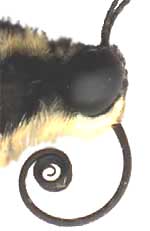
A butterfly's proboscis up close.

Well, if you look at the picture below carefully, you will notice that there is like a rolled up ribbon -like thing where the mouth should be. That thing, is called a 'proboscis', which is a turbular sucking organ. When the butterfly has found nectar, it extends its proboscis like a party blow-out.

A Monarch Butterfly

A butterfly's proboscis is like a party blow-out.

A butterfly's proboscis up close.
June 26, 2006
Of butterfly&mothballs
Butterflies are often associated with pretty, delicate little creatures: their beautiful wings and petite bodies are images of being free, pretty and pure.
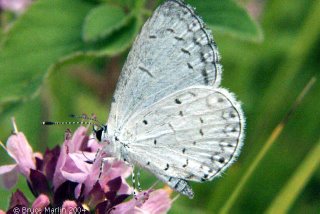
a Spring Azure butterfly
Moths however, often get the bad name...most probably from 'mothballs'. But anyhow, the common "eyes" found on moths aren't as fascinating as the feathery snow white found on Spring Azures.
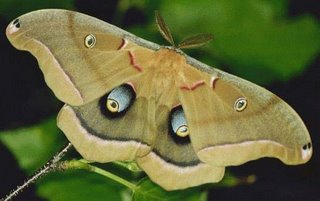
a polyphemus moth
Then again, there are moths which do not have "eyes" their wings. So the question would then be, how do you tell the difference between a moth and a butterfly?
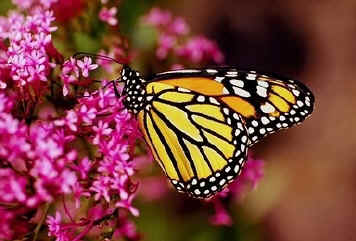
Which is which?
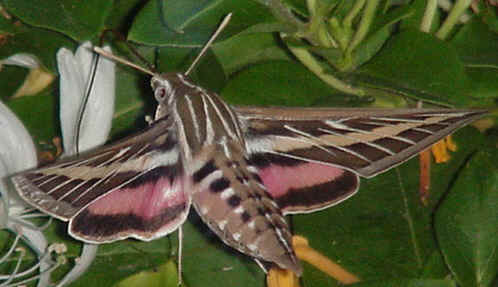
Well one way to tell the difference between a moth and a butterfly is by looking at how it rests. A moth will always rest with its wings open while a butterfly always keeps its wings at a vertical position during its resting position.
So the next time you see a 'butterfly' resting with its wings open, you can be sure it's a moth! =)
PS. It is not true that moths are uglier than butterflies. Moths have awesome colours, as it is with this sunset moth (Urania riphaeus).


a Spring Azure butterfly
Moths however, often get the bad name...most probably from 'mothballs'. But anyhow, the common "eyes" found on moths aren't as fascinating as the feathery snow white found on Spring Azures.

a polyphemus moth
Then again, there are moths which do not have "eyes" their wings. So the question would then be, how do you tell the difference between a moth and a butterfly?

Which is which?

Well one way to tell the difference between a moth and a butterfly is by looking at how it rests. A moth will always rest with its wings open while a butterfly always keeps its wings at a vertical position during its resting position.
So the next time you see a 'butterfly' resting with its wings open, you can be sure it's a moth! =)
PS. It is not true that moths are uglier than butterflies. Moths have awesome colours, as it is with this sunset moth (Urania riphaeus).

June 19, 2006
Snail? Slug?
June 13, 2006
Lesser Known Fact of the Giant Panda

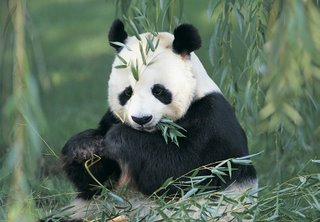

Pandas are cute.
Pandas are also endangered. We all know that, don't we?
And we all know why too; the normal reasons...habitat lost and low birthrate.
Another thing we all know is that pandas eat shoots and leaves.

What kind of shoots and leaves?
Well, bamboo shoots and leaves of course!
One thing not many of us know that one of the reasons why the panda is endangered is because of the life-cycle of it's staple food: the forementioned bamboo.

Although the bamboo trees we see around don't have flowers, bamboo trees do flower. It's just that they flower on the average every 28 years.
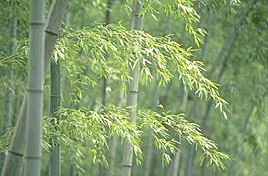
The catch here is that bamboo is monocarpic. This means that after they have finished flowering, the plant will die. According to Wikipedia, the plant being monocarpic is thought to have evolved because it reduces the effect of predators of the seed, who would be unable to depend on a predictable food supply.

To add to that, bamboo trees flower together, at the same time.
So every 28 years or so, the entire bamboo forest dies, leaving the pandas with no food. And if they're not successful in finding another bamboo forests, poof, off they disappear (to heaven I meant...or wherever animals go when they kaput. The sheol maybe. Heh) .
A Bamboo Flower
June 10, 2006
Unfrozen Reindeer
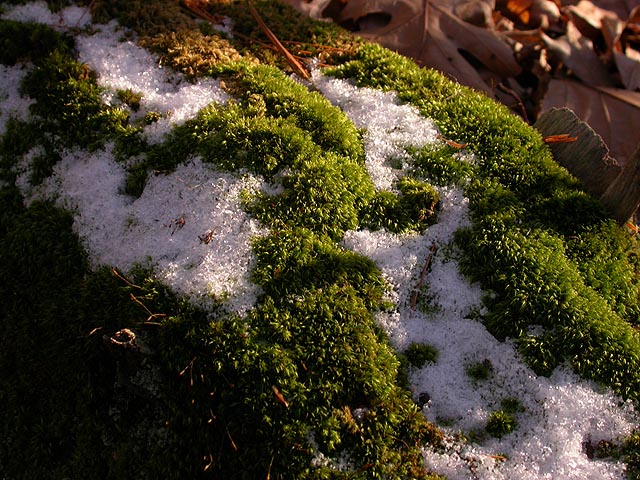
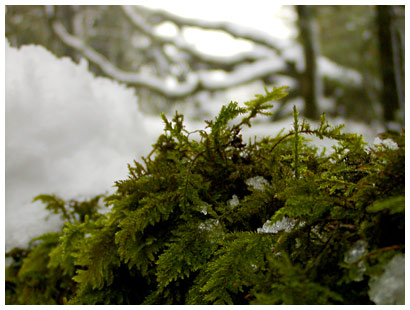


All of us are pretty familiar with reindeer, them being made popular along with Santa Claus and chimneys and snow. Oh, and not forgetting dear Rudolph with his red nose.
But it is true, these herbivorous carribou have this warm, fatherly look about them. In my imagination, when a reindeer talks, it will be a deep, gentle and soothing tone to it. Lol.

But as warm and friendly we might like them to be, reindeer have to make a pretty brutal journey across theArctic region annually. Why brutal? Clearly you've never been to the Arctic. It's just snow and ice and a dimly lighted sun. Despite being herbivores, food is still pretty rare.
Not to mention the freezing temperatures? It's pretty obvious reindeer don't have the kind of blubber penguins, polar bears and walruses all have.
Their simple anti-freeze trick? Moss.

Most animals don't eat moss because it isn't easy to digest and has little nutrients. I can't tell you about the taste since vegetables (which I assume most herbivores love) isn't exactly peanut butter to me.
Anyway, before the long journey, reindeers will fill up with lots and lots of moss because it contains a chemical that helps the body of the reindeer keep warm. This prevents them from freezing to death.
I wonder if it works with humans too. Then the Everest climbers could just keep a diet of strawberry-flavoured moss or something. ;)
June 08, 2006
January 09, 2006
Gila Monster




This is one of the only two venomous lizards in the world, the other being the Mexican Beaded Lizard (Heloderma horridum). This is called the Gila Monster. And contrary to popular Malaysian belief, no it's not called gila monster because it's crazy (gila in Malay means crazy), but named after the Gila Basin in Arizona.
There are two types of gila monsters- the reticulated gila monster (Heloderma suspectum suspectum) and the banded gila monster (Heloderma suspectum cinctum). Gila monsters eat small mammals, lizards, frogs, insects, birds and bird eggs. They have a forked tongue and a very keen sense of smell to help it track down prey.
Their stumpy tails are for storing fat, in which they use up when hibernating during winter. They are venomous, but not in the sense of venomous as we know- they don't have fangs like snakes, but their venom glands are like our saliva glands. The gila monster is said to use its venom for defensive purposes as most of its prey are small and do not require venom to kill it. Its bite is a brutal half-inch deep one, sometimes tearing the flesh away to let the poison flow deeper into the wound. As brutal and violent as this sounds, the gila monster's venom is not usually fatal to humans, though the bite will cause awful pain.
Despite the venomous bites and crazy name, gila monsters are very beautiful lizards, and in fact, not monstery at all.
Newly hatched babies (they are oviparous) have vibrant and more distinct coloured skin:
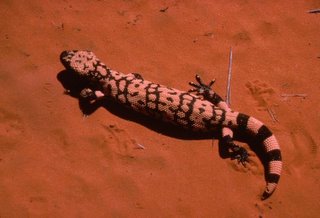
Subscribe to:
Posts (Atom)
